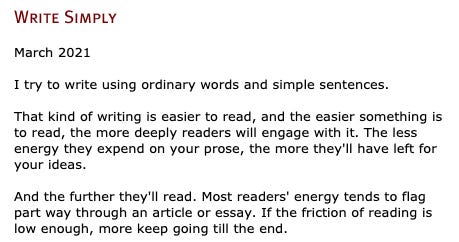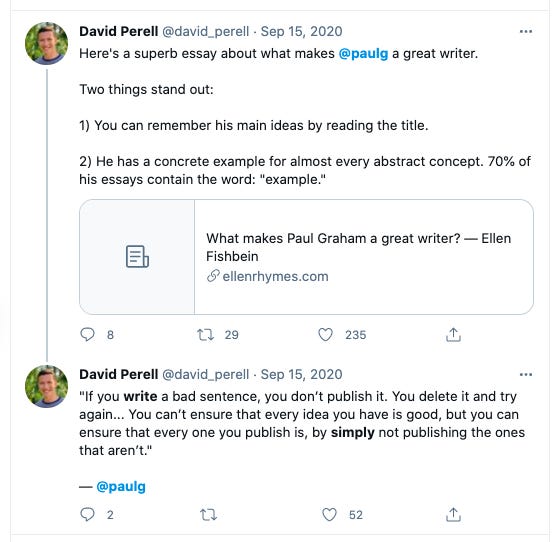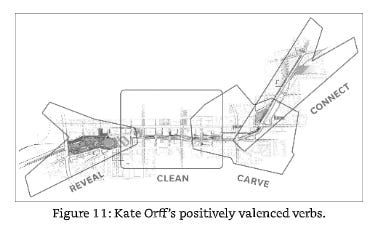Book review: Subtract: The Untapped Science of Less
post by Aaron Bergman (aaronb50) · 2021-05-23T20:21:21.685Z · LW · GW · 3 commentsThis is a link post for https://aaronbergman.substack.com/p/book-review-subtract-the-untapped
Contents
1. Intro 2. Good science “Can” to “must” 3. Why we add Biology Signalling Scarcity Innate arithmetic Culture Monuments Materialism Writing The field and the objects Economics An example More-ality More for its own sake Political economy 4. Putting it into practice Beyond “good enough” Noticeable less The problem A skeptical stance The solutions Subtraction for systemic change Remove the bad Helpful constraints Subtraction and the climate A publicity problem Streamline the message Information to wisdom Takeaways Analysis: the review part None 3 comments
1. Intro
In a bold revolt against the tyranny of the Lindy effect, I recently finished Leidy Klotz’s month-old book Subtract: The Untapped Science of Less.
Klotz’s central argument is that individuals and societies systematically neglect subtraction as a means of change, and that this leaves plenty of low-hanging fruit for those willing to embrace it. At first glance, the book might appear to an ironically-redundant rehashing of the well-worn themes exemplified by Marie Kondo’s The Life-Changing Magic of Tidying Up, the Netflix documentary “Minimalism,” Cal Newport’s Digital Minimalism, and the whole genre of cultural revolt against mindless material accumulation, information overload, and endless itineraries.
Maybe there’s a bit of this, but Klotz makes it clear that he’s discussing subtraction, not just “small amounts;” rates, not levels. It’s a subtle distinction, but an important one. When a friend proudly declares that he had created celebratory “no-bell” to ring as reward for declining unnecessary tasks, Klotz remarks that “if he wasn’t always so helpfully skeptical toward my ideas, I might have thought twice about pointing out that saying no is no subtracting.”
With that point out of the way, let’s get to the book’s biggest strength:
2. Good science
In a mid-replication crisis world, we should be very skeptical of pop-psychology books purporting to show the importance and universality of some (even mildly) counterintuitive phenomenon. Leidy Klotz, who is officially a professor of engineering but whose research is genuinely interdisciplinary, preempts this critique by documenting his long and laborious path to establishing “subtraction neglect” as a genuine phenomenon.
As an engineer, Klotz begins to suspect that humans systematically neglect subtraction. To test his hunch, he recruits Ben, the psychologist of “no-bell” fame who “not only ran the marshmallow test on his child, he also had his partner blindly replicate it, just to be sure.” Throughout the first chapter, Klotz regularly asks questions like:
Still, how could we be sure that we hadn’t created situations that discouraged subtraction? In our writing study, for example, maybe we had provided initial writing samples that were missing key information, and therefore required adding.
and
Building, writing, cooking, scheduling—our findings showed that adding more than subtracting is widespread. Our next question was: Could we generalize what we were observing? All else being equal, would people add more than they subtract?
After some initial confirmatory results, Leidy and Ben add Andy, a postdoc who is “laid-back, except when it comes to devising, conducting, and picking apart his research.” Together, they systematically check whether their results could be an artifact of study design.
Did they make it physically or cognitively easier to add, perhaps because legos are easier to put together than pull apart? Did people just like the things they were adding? Did subjects conceptualize subtracting as “adding” lightness or space? No, no, and no.
Excited at their growing body of findings, Klotz reports that he “couldn’t help but jump to the implications of what we were seeing.” Fortunately for the robustness of his research, the ever-rigorous Ben reminds Klotz, in my favorite line of the book, that
‘We need to go from can we believe that people neglect subtraction to must we believe that this is the case’
“Can” to “must”
In order to reach the “must” threshold, Leidy, Ben, and Andy needed to ensure that their subjects were really neglecting subtraction—not just choosing addition after conscious deliberation. After all, as Klotz describes, “if we choose to add, for whatever reason, then our ‘interesting phenomenon’ isn’t necessarily a problem.”
Indeed, even when people were explicitly reminded of subtraction—along the lines of “keep in mind that you can add things as well as subtract”—they systematically neglected subtraction in favor of addition in a variety of settings. Finally, after years of meticulous experimentation with his colleagues, the team became convinced that subtraction neglect is a real, important, and interesting phenomenon. And I agree.
Only the first chapter of Subtract is based on Klotz’s original research. In the rest of the book, he draws together evidence from biology, psychology, economics, and history, interwoven with personal narrative and historical anecdotes, to explain first why we neglect subtraction and how embracing subtraction can help us as individuals and improve society.
3. Why we add
Biology
Signalling
Chapter 2, “The Biology of More,” could have come straight from Robin Hanson and Kevin Simler’s The Elephant in the Brain—that is, aside from the fact that Klotz uses the phrase “showing competence” in place of “signalling.” Both works use the bowerbird as an illustrative example; thanks to sexual selection, male bowers spend lots of time and energy building elaborate nests that never get used simply to “provide visible proof [to potential mates] that the builder has good genes.”

Klotz (and Hanson and Simler and I) thinks humans aren’t much different:
The problem is that it can be harder to show competence by subtracting….No matter how beneficial an act of subtraction is, it’s not likely to leave as much evidence of what we’ve done.
Scarcity
Signalling isn’t the only reason that addition is coded into our genes. Much as our inclination to overeat was advantageous in the premodern world, our instinct for addition was adaptive when resources of all kinds—clothes, food, tools—were scarce and costly to create.
Hoarding behavior, after all, is common in other mammals. Rats will stockpile food even when their stockpile is repeatedly taken away by researchers (which is kinda mean, tbh), and
this same stockpiling has been observed in other mammals and even in birds. When similar behavior is found across animals that evolved from a common ancestor hundreds of millions of years ago…that behavior is probably a biological instinct.
Innate arithmetic
While signalling and accumulation as a response to scarcity can be found on many branches of the phylogenetic tree, Klotz closes the chapter with a biological phenomenon at least adjacent to one of Homo Sapiens’ unique advantages, mathematics.
As it turns out, young children who cannot perform arithmetic are still quite able to estimate the results of addition and subtraction problems. And, as you can probably guess by now, they’re much better at the former. Five year olds can more reliably answer questions like
Rose has twenty-one candies.
She gets thirty more.
Ada has fifty candies.
Who has more?
than
Rose has eighty-one candies.
She gives thirty away.
Ada has fifty candies.
Who has more?
Even though Rose winds up with 51 candies both times.
Klotz tries to attribute this to the fact that our intuitive sense of the quantity 80 is weaker than that of 20, and so a math problem that depends on the former will be harder to intuitively estimate. This seems plausible, but it’s a shame that nobody seems to have checked whether toddlers are indeed worse at ‘30-20’ than ‘30+20,’ in which the initial values are held constant rather than the results.
Culture
Monuments
Klotz thinks we have culture to blame too. Not just modern or “Western” culture, but the near-universal dynamics of civilization. Klotz recounts the historical evidence that monumental architecture is not a mere aesthetic novelty or even a result of civilization, but a primary cause of civilization
The intuitive story (which I guess I implicitly held without ever really considering it) goes like this: people come together, towns become cities, city states become empires, blah blah blah. Eventually, the ruling elite has enough wealth to sponsor the creation of big-ass, impressive-looking buildings like the Roman Colosseum or the Mayan and Egyptian pyramids.
Apparently, this is generally wrong. Monuments often come before the wealth, golden age of culture, and social and political integration. The Washington Monument, for example, was built when D.C. had a meager population of 30,000.More remarkably, the archeological record shows numerous cases of non-functional, large structures in areas devoid of normal living materials such as houses and pots, indicating that monuments or temples may have been the reason that small groups gathered together in the first place. Civilization came later.

This is super interesting in its own right, but it’s not at all clear to me how this ‘monuments before civilization’ theory is a cultural cause of our proclivity to add. If anything, it seems to be evidence of an innate, biological instinct that drove early humans across earth to create large structures.
Materialism
The second facet of culturally-induced addition Klotz highlights seems more causally potent: material culture.
The argument goes like this: “material culture,” the social and cultural meaning attributed to physical items, enables cooperation and social organization at large scales. Whereas in small bands (<=Dunbar number) of hunter-gatherers, “everyone could learn one another’s traits, skills, and favored cuts of mammoth meat,” larger groups needed a symbolic organization system to do the same. For instance, the material and style of one’s clothes would begin to indicate profession, wealth, religion, or other socially-important characteristics.

This, in turn, gave people reason to accumulate things that were useful for indicating a desired characteristic. Klotz doesn’t say this explicitly, but intuitively it seems that more would generally come to indicate wealth, status, and other ‘good’ things. Buying or making something—particularly something non-functional like jewelry—is a credible signal that one has time and money to spare.
As a side note (from me, not Klotz), this has reversed to some extent in the modern world. Just as thinness is high-status in a world of abundant calories even for the poor, the minimalist aesthetic exemplified by Marie Kondo et al is high-status in a world where even relatively poor people (in the developed world, at least) can accumulate lots of material goods.
Writing
Perhaps the most convincing cultural cause of addition is writing. Writing, and information storage in general, asymmetrically favors creation. This is true both for information itself and for physical items.
It facilitates trade and general economic production, feeding the interpersonal arms race of material culture. It empowers governments and other institutions to bring people together at a larger scale. It makes storing information easy, and disposing of it unnecessary. It’s a bit odd to me that Klotz only gives writing a few paragraphs—much fewer than monumental architecture— since it seems particularly important to me.
The field and the objects
The most speculative argument in this section, Klotz suggests that cultural promotion of independence encourages us to neglect subtraction. Like me, you may have heard that people in Asian cultures tend to psychologically emphasize their role in relationships (e.g. teacher of my students, Jane’s friend, brother of Maria), whereas Westerners tend to conceptualize individual attributes as central and relationships as ancillary.
Apparently, this extends beyond the interpersonal world; some cultures, like those of coastal cities in the U.S., emphasize “objects,” whereas others, like Chinese Confucianism, emphasize the surrounding “field.”
None of this is controversial, but Klotz goes on to speculate that field-oriented understanding enables subtraction in a way that object-oriented thinking does not. In his words, a “focus on individual objects [causes us to]…fail to consider taking them away from the surroundings.”
This seems like an interesting debate for artists, cultural critics, and philosophers, but I’m not so sure how plausible it is. Couldn’t we say that an object-oriented worldview promotes subtraction by emphasizing the things that we might subtract? Also, Klotz doesn’t present any evidence that Americans neglect subtraction more than Chinese people, which would bridge the speculative divide between culturally-influenced worldview and subtraction neglect.
I think Klotz realizes he’s on shaky ground, because he concludes with the weaker claim that “how we view a situation shapes how we try to change it” even if “speculating about cultural differences is fun to do over drinks.”
Economics
An example
Klotz opens this chapter with the personal anecdote I found most memorable. In the midst of writing the book, he and his wife decided to renovate their home. Inspired to see what subtraction had to offer, he solicited “Addition by Subtraction” design proposals from his architecture and engineering students, with the best submission to receive a $1000 prize.
Despite his genuine commitment to the task, Klotz admits that he never removed anything from his existing house (which, recall, would be distinct from minimalist or simplistic design). The reason is simple: house valuation increases with square footage, and he couldn’t justify spending money to decrease the value of his house. Even if he, his wife, and his kids all appreciated the removal of some space or feature, the market’s invisible hand would only punish them for the decision.
“Ok,” the neoliberal-shill inside me thought, “doesn’t this just mean people prefer larger houses? There are no magic appraisal Gods who decide that larger houses are worth more.” But the heterodox economist inside me had a few responses.
For one thing, some of this “preference” for addition could reflect everyones’ belief that everyone else wants a larger house. After all, homes are investments as much as they are consumer goods. Let’s say 90% of people like big houses and 10% of people like smaller houses with a larger yard. If you’re in that 10%, you can’t just naively pay more for a smaller house, since you know that the value of your house will reflect that this is a minority position. This isn’t true for, say, t-shirts. If 90% of people like blue t-shirts and 10% of people like yellow t-shirts, the yellow-loving mavericks can just buy a yellow shirt without worrying about its appraisal value.
Yes, in a perfectly functioning market perhaps you could expect to sell to a fellow ten-percenter, but selling a house is very hard in real life and real estate is about as liquid as tar. Reducing your buyer pool by 90% seems like an unwise thing to do.
On top of all this, houses are signalling devices as well. We can feel compelled to enlarge our houses the same way that some are compelled to purchase and wear jewelry to signal their wealth. Even when people “genuinely” like large houses and jewelry, this preference may itself be the product of social conditioning.
More-ality
The author’s more general point is that economic growth has become a key socio-political goal. And, of course, economic production asymmetrically favors addition. It wasn’t always like this. In Klotz’s words,
throughout history, most upstanding citizens…were not in the business of adding wealth. Entrepreneurial traders and merchants could even be social outcasts, or worse. (Just look up usurers in the Bible.) Sure, there were oligarchs, feudal lords, and icons of excess…But most people weren’t pursuing economic more.
Then, along came Adam Smith and the industrial revolution and before long, Harry Truman was calling for “more food, more clothing, more materials for housing, and more mechanical power” in his inaugural speech, which
canonized a patriotic duty to consume and took this same thinking global. The United States backed a system in which everyone could—and should—pursue dreams of economic wealth. More was now a moral objective, the key to peace.
This ideological current had concrete implications, and manifested in affirmative pro-growth and therefore pro-addition policies across the globe. The result: global GDP per capita rose from $3,000 in 1950 to $14,500 in 2016 despite the population tripling (which means total economic wealth increased about 15 times).
Klotz makes sure to mention that all this growth is largely a good thing. He affirms that it drastically cut poverty, promoted literacy, reduced violent conflict, and generally presented billions with the “choices and opportunities that Mimi,” his grandmother, “did not.” But, he says, “just because more has made things better, doesn’t mean that less cannot.”
More for its own sake
You might have heard the ruefully amusing anecdote that John Maynard Keynes predicted in 1930 that his grandkids would be working 15 hours a week. As you know, that didn’t happen. Instead, we got affordable consumer goods, completely unaffordable education, healthcare, and housing, 40-80 hour workweeks, and lots of inequality.
Klotz isn’t super clear, but I think he’s arguing that the ideology of economic growth, or “more-ality,” has metastasized into a big socio-economic tangle of incentives that keeps people too busy for their own good. People take on meetings and appointments “not because they [are] required to but because they [feel] it would be socially unacceptable not to.” “Busy” has become a boastful signal, indicating that we are in-demand and willing to take on the challenge. The more we work, the more we are rewarded with money and status.
And so, we live in a culture with ads like these:



The one key point he doesn’t make explicitly in this chapter (though could be inferred from later ones) is that opportunity cost is invisible. When we add materially by purchasing, we don’t immediately see what that money could have been used for instead. We can see the concrete, tangible output from adding (and completing) a task on the to-do list, but can’t so easily discern the stress-relieving, slack-enabling benefits associated with the free time created from task removal or refusal.
Political economy
A related point is that addition creates entrenched, concentrated stakeholders in a way that subtraction does not. The beneficiaries of a new action or policy often become a potent constituency for its maintenance and expansion. On the other hand, the benefits associated with subtraction, like a slight decrease in price from the removal of a burdensome regulation, are often more diffuse and less salient.
Obamacare is perhaps the greatest example. For a decade, the GOP promised to repeal the ACA. That is, until they had the opportunity. When push came to shove, the constituency of ACA beneficiaries mustered just enough political power to prevent the GOP from taking away their healthcare. This was a good thing! As Klotz regularly reminds readers, addition is often good and subtraction is often bad, even if we systematically neglect the latter.
I’m naturally skeptical of anyone who bemoans “regulations” while failing to name specific rules that ought to be eliminated. Nonetheless, Klotz (who regularly puts his liberal bona fides on display) made me somewhat more sympathetic to the general sentiment.
The increase in the Code of Federal Regulations from 10,000 pages post-WWII to 180,000 in 2020 likely doesn’t only reflect a genuine growth in complexity of the real world (though I’m sure that’s part of it), or nefarious regulatory capture. It also reflects the asymmetric ease of addition and difficulty of subtraction, in the same innocent but pernicious way that our to-do lists and quantity of material possessions tend to expand in size.
In all 180,000 pages, it isn’t hard to find a few particularly absurd examples. One exception that proves the rule (of subtraction neglect, that is) was an EPA classification of milk as an “oil,” which required dairies to spend thousands of dollars in anti-milk-spilling prevention devices. Its eventual 2012 removal showed the empirical possibility and latent potential (apparently saving over $1 billion) of regulation repeal, but the fact that it took over four decades demonstrates as well how arduous the process can be.
This “political economy” lens doesn’t just shed light on public policy. On a family vacation, for example, whoever really wants to visit that sixth art museum might well be able to overpower her parents and siblings who would only slightly prefer to remove it from the itinerary.
4. Putting it into practice
In the next section of the book, Klotz goes into self-help mode to teach readers how they can put subtraction to good use. While “self-help” has a quasi-pejorative connotation, I don’t mean to make a mockery of it. The lessons, insofar as they apply at the individual level, also apply to public policy and institutional design.
Beyond “good enough”
The first novel concept in this section is that of “post-satisficed less.” That is, subtraction beyond the point at which addition makes the system better. Subtracting just for the heck of it is somewhere between useless and reckless (for instance, removing a car’s brakes to save weight and space). Banal as it sounds, this just means subtraction should be a means of improvement, not an end in itself.

In practice, this implies that adding and subtracting often go together. Add what’s good, and take away everything else. Once again, banal, but a worthwhile reminder nonetheless.
Hilariously, Klotz seems to completely neglect his own advice. The single worst example in Subtract has got to be this “improved” version of the above chart:

Maybe it’s just me, but this is totally useless! At least label the axes! Especially since you’re trying to convey three variables—mental steps, quality, and ‘amount’—in a single 2d, black and white graph!
Noticeable less
The problem
One of the more important and personally-resonant sections of the book is Klotz’s recognition and discussion of the need to make subtracting noticeable. After all, one of the fundamental causes of subtraction neglect is the fact that addition is often a credible signal of competence, whereas we often can’t even tell that subtraction took place.
Take writing. Even when removing a word or section objectively improves some text, readers usually don’t know that a section was removed. I run into this issue all the time as a student. Unless a professor repeatedly and explicitly emphasizes that he or she is looking for simplicity and brevity, I choose to signal my knowledge and understanding by erring on the side of more. Frankly, I’d rather come across as verbose but competent and hardworking than straightforward but lazy.
In fact, I’m implicitly doing the exact same thing in this post. On one level, this is likely out of habit and simple lack of skill. On another, I definitely do want to seem smart, interesting, and competent to anyone who comes across it, even though I’m not consciously consciously thinking as much when writing. And, whatever the reason, it is empirically true that longer blog posts get linked to and shared more often.
For another perspective, check out the finalists of the Astral Codex Ten book review contest. One non-outlier that I greatly enjoyed, a review of Progress and Prosperity, is around 18,000 words, and my Chrome text-to-speech plugin says it would take almost an hour to read out loud on the fastest setting. By comparison, this post (which took a fair amount of time to write) is fewer than 7,000 words and would take my plugin about 15 minutes.
Yes, these are anecdata, but I think they reflect a genuine correlation between quantity and quality in domains from athletics to academia. Even though the best writers do economize words, they also probably write quite a lot! I doubt professional authors were the students typing gibberish in white font to boost their word count back in high school.
Anyway, this is a real problem for aspiring subtractors. How can we get credit for subtracting?
A skeptical stance
Unfortunately, Klotz’s proposed solutions to this dilemma strike me as a bit futile. He highlights Bruce Springsteen’s widely acclaimed album Darkness on the Edge of Town, which the musician described “as his ‘samurai record, all stripped down for fighting.’” The songs have a few powerful lyrics, the instrumentals are equally slim, and Springsteen even removed several excellent songs from the album itself.
According to Klotz, the album’s critical acclaim as “nothing less than a breakthrough” and recipient of a prestigious ‘Album of the Year’ award in 1978 demonstrates how minimalism and subtraction can be understood as excellent. Fair enough, sort of, but Springsteen was already established as an artistic icon by Darkness. He didn’t need to prove his musical talent to critics and fans. I strongly suspect that established high-performers in any field have two distinct advantages for subtraction.
First, evaluators will view their output through a charitable lens. When you have no doubt that an artist is capable of complex, intricate instrumentals and lyrics, it is only sensible to understand their absence as a deliberate artistic choice. Implicitly, fans and critics are more likely to interpret this as good “post-satisficed less” instead of bad “lazy less.”
Second, subtraction is less risky for established players. Even if critics do understand the output to be of poor quality, a comfortable stockpile of credibility pads the landing. Had Darkness come across as utterly simplistic and vacuous, Springsteen still would have been seen as an all-around great musician.
I think Paul Graham, co-founder Y-combinator and Hacker News, is a perfect demonstration of the subtraction-enabling advantage of pre-established excellence. In addition to being a renowned venture capitalist and tech insider, he publishes essays like “Write Simply” on his website.


Indeed, Twitter loves Paul’s ‘stripped-down’ style. And I agree! As a reader, I appreciate clarity and simplicity. Nonetheless, I don’t think that I, internet rando and current undergrad, would be afforded the same degree of charity.
Rereading the start of this post, it is apparent that clarity and simplicity are not my dominant concerns. Maybe they should be. Maybe I should stop taking part in the signalling arms race, stop playing 4-d psychological chess with my writing, and just try to convey my ideas as simply and effectively as possible without worrying about rhetorical flourish. I hope that, in the future, I’ll feel a bit more license to do just this.
Like so much else in life, it’s signalling and counter-signalling all the way down. In the social world, perceived competence cannot be divorced from current reputation.

The solutions
Klotz does offer a few suggestions to make subtraction noticeable above and beyond “if you do it well, people will notice.” Empirically, the word “subtract” has a negative valence or connotation. Fortunately, the thesaurus provides plenty of alternatives. Don’t say “subtract” “remove,” or “eliminate.” Say “reveal,” “clean,” or “streamline.”

Of course, this only goes so far. Clever semantics can reframe only the representation of a thing, not the thing itself. It might help you get a patent, but the innovation itself (probably) won’t come with a sign that says “this isn’t subtraction, it’s simplification!” or something.
A closely-related but distinct strategy is conceptual reframing. Rather than merely replacing one word with another, we can actually change our understanding of some phenomenon. Marie Kondo, for example, doesn’t implore us to “get rid of useless shit,” but rather “to keep only what sparks joy.” Yes, there are different words representing two different concepts, but the conceptual reframing itself seems more fundamental and potent to me
Subtraction for systemic change
Remove the bad
In the next chapter, Klotz argues that subtraction is a particularly effective means of systemic change. He opens with the example of South African apartheid. When 25 years of domestic and international protests following the Sharpeville Massacre of 1960 failed to abolish the system, subtraction finally stepped in. Boycotts and divestment, the removal of economic support, finally ended the racist regime
To a large extent, the American boycott movement was kicked off by a black working-class man by the name of Leo Robinson. He organized fellow anti-apartheid dockworkers to do, well, nothing—that is, to refuse to unload South African cargo. According to Klotz, this action catalyzd the wider divestment movement, in which governments and companies across the world refused to do business with South Africa. The point is this:
All else being equal, adding incentives for anti-apartheid groups is not as good as removing the incentives propping up the racist system.
The same holds true at an individual level. The author reports that removing the sinful, tempting iPad from his son’s line of vision is much better at dissuading its use than, say, promising him a cookie for voluntary abstention.
Helpful constraints
Another feature of subtraction is its potential to create productive, helpful constraints. In general, forcing a system to operate under less-than-ideal conditions ultimately helps it to thrive. Klotz offers the example of his college soccer team’s strategy of scrimmaging with fewer players than they were allowed, but I can think of a dozen other examples: the story of how one of the greatest pieces of all time was played on a shitty piano as recounted in this Ted Talk, the body’s adaptation to low oxygen environments, how economic productivity increases during recessions.
One particularly important constraint involves information. Try to convey too much, and you’ll end up conveying nothing at all. This is why some of the most spectacular, depressingly-easy-to-achieve medical reforms have involved extremely brief checklists. In a famous example, adopting the following checklist as a medical norm eliminated most of the prior 30,000 annual catheter infection deaths:
- Wash hands with soap.
- Clean patient skin with antiseptic.
- Put sterile drapes over the entire patient.
- Wear a sterile mask, hat, gown and gloves.
- Put a sterile dressing over the catheter sight.
These were not novel insights, a brief addition to the existing body of medical knowledge. Rather, they were a severely trimmed-down version of the “summary of the guidelines for inserting central catheters [which ran] thirty-five dense pages…”
Of course, this anecdote is supposed to demonstrate the general case: shorter messages can, paradoxically, effectively convey more information than longer ones.
Subtraction and the climate
A publicity problem
Despite containing a whiff of the anti-growth, eco-reactionary sentiment sometimes present on the left, the penultimate chapter is a reasonable but incomplete account of how our society can put subtraction to use for the planet.
There are two central ideas, which I gleaned from Klotz’s interwoven analysis of Costa Rica’s climate policy, Dr. Seuss’s The Lorax, and the IPCC’s infamous climate change reports. First, “subtraction has a publicity problem,” since “what has been subtracted is no longer visible.” In the context of climate change, “no one is going to see less carbon dioxide in the atmosphere.”
The solution, he thinks, is to remove the invisibility cloak, perhaps by enshrining subtraction into law, as Costa Rica has through its pioneering pledge to become carbon-neutral and publicized reforestation efforts.
In his mind, the problem is one of psychological biases and misallocated salience. If only we could get policymakers to focus less on GDP and more on the U.N.’s Human Development Index, publicize carbon-capture efforts, and make big, splashy public commitments to reduce emissions, the problem could be solved.
These are all great, don’t get me wrong, but I think he’s missing the main point: people get money when they do things that emit greenhouse gasses, and they don’t get money for taking it away. No amount of publicity campaigning or macroeconomic metric reform can change this fact. Pay a flat rate for each ton of carbon removed, put a tax on the carbon itself, and let the market do its thing.
Streamline the message
I’m more sympathetic to his second point, which also concerns messaging: just as reducing the length of catheter-insertion instructions helped to save lives, it is important to emphasize only the most effective, important pro-climate policies. One exemplar Costa Rican policymaker, for example, “didn’t want to waste her time and others’ by elevating programs like recycling and composting to the same urgency as truly lifesaving measures like drastically slashing carbon dioxide emissions.”
To give Klotz his due, he seems to think that the more concrete, tangible economic policies like carbon taxation are downstream of messaging reform. According to him, the efforts described led Costa Rica to, indeed, tax fossil fuels and subsidize clean energy. That said, this constitutes just one line in a 20+ page chapter; I worry that centering the messaging and framing rather than these policies themselves draws our attention in the wrong direction.
Information to wisdom
In this final chapter, Klotz hones in on the cognitive and emotional virtues of subtraction. Leaning on Cal Newport’s (author of Deep Work and Digital Minimalism) work, he argues that the modern world is plagued by an excess of information. This is not just unpleasant, but also impedes us from “distilling” sheer data into wisdom and insight.
Overall, I agree (related: my post “On silence”). However, aside from a lengthy recounting of how he saved his engineering degree by condensing the material in his college mechanics class down to a few fundamental laws, the chapter doesn’t offer much in the way of actionable advice. For instance, Klotz proclaims that “we need to balance generating of information with selecting what is relevant and useful,” but doesn’t explore what this might entail for the reader.
I have a few more substantive critiques as well. Klotz seems to claim that society at large needs to systematically get rid of useless information. In his words,
a dark underbelly of librarianship is deciding which books to get rid of, to make room for new ones. Like Kate Orff cleaning, carving, and revealing, the librarians invert, not calling this change subtracting but instead “weeding.”
If you’re like me, weeding out a single book, even one you will never read, is traumatic. Librarians nonetheless know that weeding is necessary. The alternative is pulping: indiscriminately taking entire sections of books to a plant where they will be…reconstituted as paper. When pulping took 210,000 nonfiction books from Manchester Central Library in the UK, the process brought brought librarians to tears. It was “cultural vandalism at industrial scale.” Who’s to say a book not checked put in the last ten years won’t bring someone to joy, or become the basis on which civilization is reconstructed? Weeding books is like our brain’s synaptic pruning; pulping is a lobotomy?
I think this is just…wrong? While I agree that “the opportunity cost of information” is a genuine concern at the level of an individual or a specific project, the same is not true of society at large.
Unlike my brain and my computer, civilization has no practically-relevant constraint on the number of books contemporary civilization can physically store. Perhaps an individual library needs to take some books off their display shelves, sure, but are there really no warehouses in the middle of Nebraska that can house millions of probably-useless books for the rest of eternity?
This stood out to me thanks to another recent ACX book review contest finalist, this time of the book Double Fold. Klotz’s writing shares the same head-shaking, solemn, “this is necessary” tone as those of the librarians described in the book, who believed we had to digitize hundreds of thousands of books before their pages physically eroded. What ended up happening, sadly, is that countless newspapers, magazines, and books were turned into terrible quality microfilms and then destroyed. Quite seriously, “cultural vandalism at industrial scale.”
This is a small part of the book, but it raises a bit of a red flag for me. If I was able to recognize Klotz’s inappropriately uncritical acceptance of some pro-subtraction narrative in the one domain that was serendipitously the subject of a book review I just read, what other parts of the book might not hold up to scrutiny?
Second, Klotz says that
One of my favorite less-is-more productivity tips is to write down fewer notes. This is the information version of the closet-cleaning tip in which you get rid of anything you haven’t worn for a year. In both cases, you are forced to filter important content from inessential content…
I still write some things down…But I trust my brain for big ideas.
I have a different take. In my mind, notes are a way of making cognitive room for what matters. By outsourcing memory storage to a word document or piece of paper, my brain is relieved of the burden of holding sheer amounts of information. That’s how it feels, anyway
Also, in my personal experience, writing stuff down is enormously generative. I can have a quarter-baked idea, stick it in the notes folder on my phone, and then let it marinate in my subconscious.
In fact, most of the posts on this blog began their life as a line or two in the “ideas” note on my phone, about 90% of which will never see the light of day. Looking at my list, most of the ideas from more than a month or two ago I almost certainly would have forgotten. Is there a tradeoff? Sure; I’m glad I don’t literally record every thought that crosses my mind. But on balance, I think it’s wise to err on the side of more.
Takeaways
To his credit, Klotz concludes with a summary of the main ideas presented, which I will quote briefly:
Invert: Try less before more…don’t “subtract.” Instead, clean, carve, and reveal.
Expand: Think add and subtract…Adding should cue subtracting, not rule it out…So sure, add diversity, but subtracting racism is the prize.
Distill: Focus in on the people…Strip down to what sparks joy…Subtract information and accumulate wisdom
Persist: Keep subtracting. Can you make less undeniable. Bruce Springsteen made Darkness visible. Costa Rica made neutrality noticeable.
Analysis: the review part
Subtract has two distinct parts. The first chapter, about 10% of the book, is a narrative-style account of Klotz and colleagues’ rigorous and valuable research program. The other 90% is, well, not.
Here is what I think happened: a smart, ambitious, acclaimed academic makes an important discovery, and decides to write a book. Unfortunately, an account of the research itself only stretches 24 pages. So, he puts on his Malcolm Gladwell hat on and goes to work, collecting another ~200 pages worth of personal and historical anecdotes.
Don’t get me wrong—the rest of the book isn’t bad, just unconvincing. Not all nonfiction books need to be held to such a high standard. Memoir, biographies, and history books, for instance, aren’t generally seeking to make a big claim about the world. But any text that advances a novel, general, non-obvious scientific claim has a lot of work to do.
In short, authors have available a huge number of “degrees of freedom” with which to make their point. They can pick from any of hundreds of thousands of research studies (many of which themselves are p-hacked or otherwise misleading) and literally millions of individual historical narratives or events as evidence. So, the evidence presented must be extremely convincing before anyone should accept the thesis as correct.
This isn’t impossible. The more limited the thesis in question, the easier this will be. “Remote work is a good business decision for U.S.-based white collar technology companies in the 2020s” is going to be much easier to defend than “remote work is a good business decision, period.”
It isn’t impossible to make a bold, sweeping claim convincingly either. Ian McGilchrist’s The Master and His Emissary comes to mind (well, the first half at least) as one successful example. He details, more or less, the entire literature concerning brain hemisphere differences to establish that our left and right hemispheres operate in radically different ways. After reading most of the book, I would be extremely surprised to find a robust and convincing counterargument to any of his central claims.
On the other hand, I can’t say the same about Subtract. If Klotz wanted to rewrite each chapter to argue the opposite of what it does, I think he’d be able to. For instance, I bet he could have put together an argument that subtraction neglect is not biological (chapter 2), or cultural (chapter 3) or economic (chapter 4) in origin.
I’m even more confident he could have argued that semantic or conceptual reframing aren’t effective ways of making subtraction more noticeable (chapter 5), that subtraction isn’t particularly effective for systemic change (chapter 6), that adding aerosols to the atmosphere is our only hope against climate change (chapter 7), or that information accumulation is basically a good thing (chapter 8). While I certainly agree with some of the points made in chapters 2-8, most of this agreement I attribute to background knowledge rather than Klotz’s argumentation itself.
The only chapter I don’t think he could have done this for is chapter 1, the description of his individual research. Like The Master and His Emissary, I’d be surprised (though, to be honest, not shocked) to encounter an argument that subtraction neglect is not a real and important phenomenon. Why? Because Klotz, Ben, and Andy’s research seems genuinely rigorous and comprehensive, the kind that even Stuart Ritchie of Science Fictions could get behind.
So, in the end, perhaps a hyper-speculative Straussian reading of Subtract is appropriate, as a delightfully-ironic cautionary tale of the dangers of adding middling-quality fluff to a high-quality core.
3 comments
Comments sorted by top scores.
comment by lsusr · 2021-05-23T23:42:24.525Z · LW(p) · GW(p)
The primary objective of every organization is to perpetuate itself.
Evolution is the opposite. It defaults toward subtraction because random mutation biases change in favor of the removal of genes. (Note: Life has evolved many ways to minimize genetic drift towards noise. Genetic repair can only slow this effect. Life has not fully overcome entropy.)
I first realized the worthlessness of stuff when I lived in Italy for a year. All I took with me was one large backpack of stuff. The rest of my stuff I left in my landlady's attic back in the US. And you know what? All I missed were some of the books. By the end of the year I couldn't even remember what else I had stored in that attic.
―Stuff by Paul Graham
I wonder how much the author's thesis applies to hunter-gatherers like the !Kung who have to carry everything on their backs? I guess a tendency toward "more" wouldn't hurt them much because their way of life places a hard limit on what they can amass. The analogy to overeating applies.
These people live below Dunbar's number, so there is no need to amass wealth to impress strangers. What does matter is impressing people in your community by amassing personal connections. Therefore the tendency is to give away conspicuous material wealth rather than amassing it for onesself.
The idea that stockpiling is an instinct makes sense. Lots of rodents do it.
As a side note (from me, not Klotz), this has reversed to some extent in the modern world. Just as thinness is high-status in a world of abundant calories even for the poor, the minimalist aesthetic exemplified by Marie Kondo et al is high-status in a world where even relatively poor people (in the developed world, at least) can accumulate lots of material goods.
Yes, though I wonder how much is hipstering. It's not like the royal family of Qatar is living a minimalist lifestyle. Then again, in The Promised Land, Barack Obama write about how his greatest personal fantasy is to walk down the street without a convoy.
Even when removing a word or section objectively improves some text, readers usually don’t know that a section was removed.
People don't notice the removal of a single thing but people do notice the collective effect of many removals [? · GW]. One of my favorite things about Less Wrong is how clean Oliver keeps it. He doesn't even allow underlines in posts.
Analysis: the review part
By your description, it feels like the kind of book where an author picks a word and then rambles about it like an impromptu speaker. If this had an extraordinary thesis requiring extraordinary evidence like Manufacturing Consent then lots of anecdotes would make sense. But the thesis seems too vague to be extraordinary.
I get the impression of the kind of book which where a dense blogpost is stretched out to the length of a book. This is ironic for a book about subtraction.
It seems to me like this book would be worth reading iff you want gentle nudges toward removing things from your life.
If Klotz wanted to rewrite each chapter to argue the opposite of what it does, I think he’d be able to.
Yes.
Replies from: aaronb50↑ comment by Aaron Bergman (aaronb50) · 2021-05-24T22:02:28.381Z · LW(p) · GW(p)
By your description, it feels like the kind of book where an author picks a word and then rambles about it like an impromptu speaker. If this had an extraordinary thesis requiring extraordinary evidence like Manufacturing Consent then lots of anecdotes would make sense. But the thesis seems too vague to be extraordinary.
I get the impression of the kind of book which where a dense blogpost is stretched out to the length of a book. This is ironic for a book about subtraction.
Yup, very well-put.
Your point about anecdotes got me thinking; an "extraordinary thesis" might be conceptualized as claiming that the distribution of data significantly shifted away from some "obvious" average. If so, showing the existence of a few data points greater than, say, 4 standard deviations from the "obvious" average actually can be strong evidence in its favor. However, the same is not true for a few examples ~2 standard deviations away. Maybe Klotz's error is using anecdotes that aren't far enough away from what intuitively makes sense.
Probably didn't explain that very well, so here is a Tweet from Spencer Greenberg making the point:
Replies from: lsusr1. By Bayes Factor: suppose hypothesis “A” says a data point is nearly impossible, and hypothesis “B” says the data point is quite likely. Then the existence of that one data point (by Bayes’ rule) should move you substantially toward believing hypothesis B (relative to A).
Example: you have had a rash on your arm for 10 years (with no variability). You buy some “rash cream” off of a shady website, and within 2 hours of applying it, the rash is gone. You can be confident the cream works because it’s otherwise highly unlikely for the rash to vanish.
↑ comment by lsusr · 2021-05-24T22:40:45.722Z · LW(p) · GW(p)
Your comment makes sense. I think the problem goes even deeper.
Many nonfiction books project all of human experience onto a single axis and then ramble about that axis. In this case, the axis is "more" vs "less". If you don't understand what "more" and "less" are then this can be educational. But if you do know what "more" and "less" are then the important thing to understand is when should you apply this axis and when shouldn't you. It is one half of a bravery debate.
Bravery debates are more about the listener than the facts. Whether you should subtract from your life depends on who you are.
He inhabited a sparse, unheated cell, its concrete walls radiating the late-fall chill. A wooden-plank tucket served as both bed and day couch, with a small stand alongside for perching texts to read—and little else. As befits a monk, the room was empty of any private belongings.
From the early-morning hours until late into the night, Khunu Lama would sit on that bed, a text always open in front of him. Whenever a visitor would pop in—and in the Tibetan world that could be at just about any time—he would invariably welcome them with a kindly gaze and warm words.
Khunu's qualities—a loving attention to whoever came to see him—struck Dan as quite unlike, and far more positive than, the personality traits he had been studying for his degree in clinical psychology at Harvard. That training focused on negatives: neurotic patterns, overpowering burdensome feelings, and outright psychopathology.
Khunu, on the other hand, quietly exuded the better side of human nature. His humility, for instance, was fabled. The story goes that the abbot of the monastery, in recognition of Khunu's spiritual status, offered him as living quarters a suite of rooms on the monastery's top floor, with a monk to serve as an attendant. Khunu declined, preferring the simplicity of his small, bare monk's cell.
―Altered Traits by Daniel Goleman and Richard J. Davidson
I don't think Khunu needs to read about how he should subtract from his life.
The problem with Subtract is that the truth-value of its thesis depends on who is reading it. I prefer to read books with observer-independent (i.e. objective) truth values.